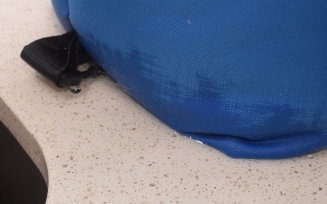Sharpening is one of those things that you know you should do often, but always gets put off. It is often said 90% of your problems with hand tools can be fixed by proper sharpening. I am getting better at free hand sharpening, and getting less lazy over time. It is hard to always have some dedicated space to sharpening though. I read an article in Fine Woodworking Magazine where someone suggested using a basic tool box plus custom top as a sharpening station. It is portable to follow you around the shop, and has all the right stuff where you need it. Instead of buying something I decided to stash bust and build one.
I have a ton of 3/4″ plywood around from my temporary kitchen counter tops, and some left over spares from the cabinet installation. I turned them into a 16×16 open fronted box, along with a few drawers.
Given that the case and drawers would be short I didn’t want to use my normal method of attachment. This typically involves building the drawer to just below the inside width of the box, and using pine as runners. It is quick and easy, but the drawers fall out if you pull too far. Instead I went with metal slides, and got to use my new drawer install tools.
I picked up a slide install tool and drawer guides from rockler. They help a lot, but are a little awkward to use. I wish I had do more research before buying. I think kreg might have a better system.
Instead of using some kind of gripy surface to hold all the various plates and stones in place I went with a small vise.
On the left is a small work surface with bench dog clamps to help hold sharpening plates. It is offset to the left to prevent drawer interference. On the right is a small granite surface plate I had. I added a protective cover to it eventually (seen in later photos). Now I can use whatever method of hand sharpening best fits the situation of the tool.

I built 3 sets of drawers to start with because it was all I thought I would need. Then I found enough stuff to add a 4th drawer. Once that was built and installed I found enough for a 5th. I probably have too much sharpening junk.
The project ended up stretching out over a month as I worked on other things and came back with more ideas. In that time I used a few different pieces of plywood for the front face of the drawers, so they don’t match well. I did cook up a cool side caddy for honing fluids though.

In all I think I am going to like it. It rolls nicely, tucks away under one of my other benches that didn’t have a use for that space, holds a lot of stuff in the drawers, and even has space on the bottom shelf for my work sharp tool box and saw sharpening clamp. The only thing it might need is weight in the bottom to help with stability. Now I have no excuse not to sharpen early and often.







































